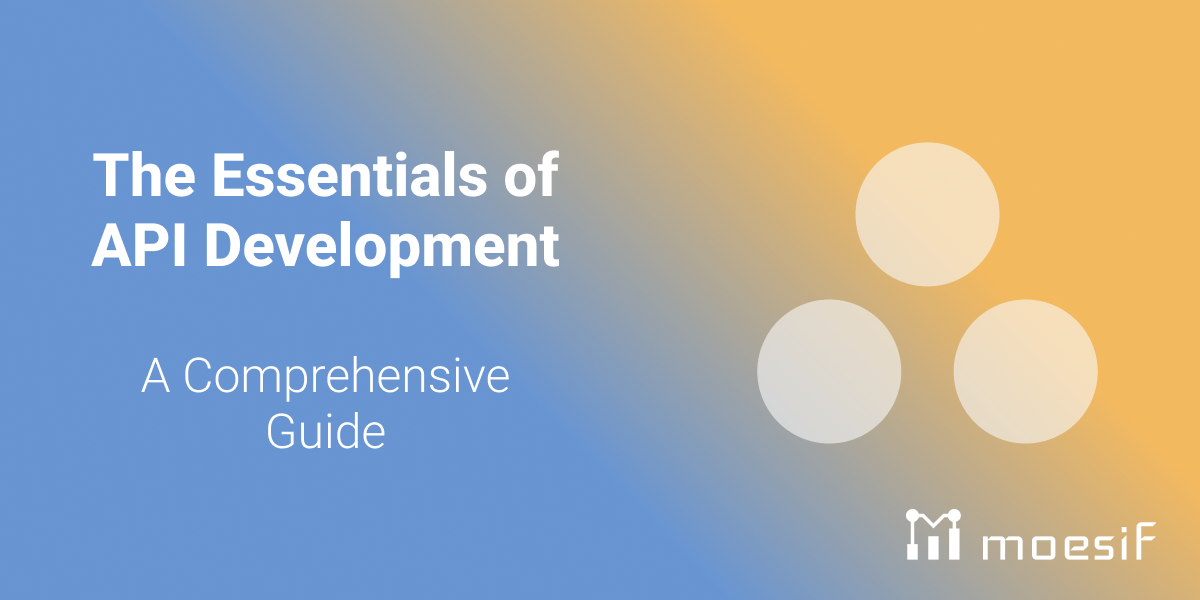The Essentials of API Development: A Comprehensive Guide

Navigating API development is essential for creating seamless software interactions. This guide strips back the complexity, offering a clear pathway through the intricacies of API creation, from brass-tacks design principles to advanced security and documentation. Among the APIs we’ll explore for their role in simplifying software interactions is the REST API. This model emphasizes functions like GET, PUT, and DELETE to interact with server data efficiently and statelessly. Whether you’re a beginner or looking to refine your skillset, let’s dive into API development essentials.
The evolution of web-based APIs, particularly the web API, marks a significant milestone in computing and API development history. These APIs have been instrumental in advancing modern web application development, including Websocket APIs, and have found applications in various fields such web applications such as e-commerce, social media, and the Semantic Web.
Key Takeaways
- APIs are not just tools; they are the key to unlocking your potential as a developer. They are fundamental to application integration and development, offering powerful capabilities for scalability, feature implementation, and building innovative software that pushes technological boundaries. With APIs, you are in control of the future of software development.
- Effective API design is not just about aesthetics but simplifying complex interactions. It hinges on principles such as consistency, flexibility, and security, with APIs serving as an abstraction layer that facilitates interactions between systems. This understanding should give you confidence in your ability to design APIs that ensure interoperability and protect against unauthorized access.
- Documentation is essential for effective API use, requiring clarity, comprehensive code examples, and regular updates to reflect version changes and maintain relevance and accuracy for developers.

Understanding API Development

Tracing the lineage of the Application Programming Interface (API) unveils a history of application programming interfaces that parallels the evolution of computing itself. From the nascent stages of the 1940s to the explosive growth of web-based APIs with the Internet, these protocols and definitions have become the cornerstone of application integration and development. Like an intricate dance, APIs lead the tempo, orchestrating the complex interplay between software components, allowing developers to build upon existing services, and imbuing applications with unparalleled scalability and flexibility.
The historical context and evolution of web APIs have significantly shaped modern web development. Their applications span various fields such as e-commerce, social media, and the Semantic Web, marking a pivotal shift in how data is exchanged and utilized over the Internet.
Developers are empowered to unlock new horizons in software development as modern API practices refine the art of API management and documentation.
The Role of APIs in Software Development
APIs are the heroes of software development, powering the data exchange and functionality sharing that enable web services to flourish. For example, a weather app that displays forecasts with a flick of a finger is a testament to the versatility of public APIs, drawing from remote databases to display real-time information through the user interface of a web service. To access these APIs, developers often require an API key to ensure secure and authorized data exchange.
Serving as the nexus of communication transfer data, API endpoints are the digital engagement where software components meet, exchange data, and part ways, ready to serve the end user. It is through APIs, particularly REST APIs, that utilize functions like GET, PUT, and DELETE without maintaining client data on servers between requests that the foundation for innovation for software applications is unlimited.
Benefits of API Development
API development champions a new age of digital automation, with customization and scalability becoming the watchwords for a dynamic software landscape. The hallmark of API development is the ability to quickly develop new features in response to the ever-changing market trends. Consider platforms like Amazon API Gateway, which streamlines the management of multiple APIs and offers compelling cost benefits, making the prospect of up to one million more of API calls, services and calls openly available.
This is the fertile ground upon which developers plant the seeds of future technologies, reaping the benefits of faster communication and data exchange, and ease of implementation.
API Design Principles

The design of a software component, an API or programming language, reflects the forethought and precision put into its creation. It is the forum where decisions are made, standards are set, and the potential for diverse use cases is realized.
APIs, acting as the abstraction layer, simplify the complexity of system operations and enable straightforward interactions between disparate operating systems. They require collaboration and diligence, each stitch representing a choice that will ultimately define the very use an API’s usability within the grand architecture of software systems.
Consistency
Consistency in API design offers predictability and reliability, which developers can count on in any situation. The cornerstone allows developers to familiarize themselves with the particular API part’s rhythm, understand its nuances, and integrate its capabilities.
The meticulous application of naming conventions, data structures, structuring of resources, and adherence to HTTP methods on a web server are the threads that rely on cohesiveness, inviting developers to build with confidence using JavaScript object notation.
Flexibility
Flexibility, the ability to bend without breaking under the diverse demands of data exchange and system integrations, is the mark of a masterfully designed API. It is the chameleon in the technological ecosystem, adapting its colors to match the environment, ensuring interoperability, and contributing to the efficiency of operations. One example of flexibility in data exchange application program interface is using extensible markup language.
Security
Security, which separates order and chaos in the digital age, is equally important in API development. Implementing a fortress of security measures, including coarse-grained and fine-grained access controls, erects a barrier against unauthorized access. The zero-trust approach, complete with HTTPS encryption and centralized OAuth servers, forms the vanguard of defense, ensuring that every last API call, endpoint and call is scrutinized for the utmost security.
Furthermore, rate limiting and caching strategies protect and optimize performance, ensuring a seamless experience for external users.
Types of APIs and Protocols
Journey through the diverse landscape of APIs and protocols, with roads as varied as the destinations they lead to. Public, partner, private, and composite APIs cater to different audiences, ranging from open developer communities to closely guarded internal systems.
Beyond availability, APIs are also distinguished by their use cases, from database to web APIs, each adhering to unique communication protocols that define their essence. Web APIs, in particular, play a pivotal role in modern web development, enabling real-time communication and interactive experiences through technologies like Websocket APIs.
RESTful (REST API) APIs
RESTful APIs, also known as REST APIs, represent the model of simplicity in the API kingdom. They leverage standard HTTP protocols in a stateless choreography of data exchange. With HTTP methods like GET, PUT, and POST serving specific roles, these APIs embody an architectural elegance that is less code-heavy and more intuitive than their SOAP counterparts.
GraphQL APIs
GraphQL APIs allow clients to define exactly what data they need, minimizing over-fetching and under-fetching. Services like AWS AppSync streamline the development of GraphQL APIs by automating the complex tasks of connecting to data sources and managing real-time updates.
SOAP (Simple Object Access Protocol) APIs
SOAP APIs employ the Simple Object Access Protocol to ensure data integrity across XML-based message exchanges and data transfers. Renowned for their interoperability, SOAP APIs facilitate operations across diverse platforms and languages, making them a secure choice for critical data transfer scenarios.
Tools and Technologies for API Development
API developers’ toolkit brims with specialized instruments, each designed to refine the process of API creation. From gateways that orchestrate traffic management to libraries and frameworks that set the stage for development, these tools make API architecture possible. Among these, an API management tool is crucial in streamlining the process.
API Development Frameworks
APIs are built on API development frameworks, which offer environments tailored to the requirements of different programming languages. Whether it’s Spring Boot’s streamlined approach to Java development or Flask’s explicit structure for Python, these frameworks equip developers with the tools necessary to construct robust APIs with precision and ease.
API Libraries
API libraries transform code into powerful functionalities. From Jackson’s adept handling of JSON in Java to Apache HttpClient’s management of HTTP requests, these libraries provide developers with a rich array of capabilities to augment and refine their APIs.
API Testing Tools
Testing, where tools like JUnit and Mockito stand guard for API reliability, ensuring that APIs perform as intended.
Integration testing libraries like Testcontainers further solidify an API’s robustness, preparing it for the rigors of real-world application.
Best Practices for API (Application Programming Interface) Documentation
As a compass, API documentation guides developers through the intricate maze of API capabilities, ensuring the full potential of the services offered can be harnessed. The bridge connects the creator’s intent with the developer’s execution, a well-spring of knowledge that must be clear, organized, and consistently updated.
Clarity and Organization
Well-organized API documentation, a beacon of clarity, is an invaluable educational tool, offering insights that transcend technical jargon for developers of all expertise levels. It ensures that every parameter, every sample query language response, is presented with such clarity that developers can foresee their interactions with the API even before making live calls.
Code Examples
Code examples are essential for API documentation. They enable developers to visualize and adapt APIs to their own needs, bridging the gap between theoretical knowledge and practical application and enhancing the developer’s journey.
Versioning and Updates
Documentation that keeps pace with change is needed to navigate the evolving landscape of APIs. Versioning and timely updates are critical in maintaining the integrity of the documentation, assuring developers of its relevance and accuracy as the API matures.
Real-World API Development Examples
Far from mere abstractions, APIs drive real-world applications across the digital spectrum. From PayPal’s secure transactional APIs to the social login features powered by Twitter, APIs are the connective tissue enabling seamless experiences in e-commerce, travel booking, and beyond.
Challenges and Solutions in API Development
Even with the most carefully constructed APIs, challenges can still arise. Performance bottlenecks and testing hurdles are but a few of the trials that developers face. However, with robust tools and a strategic approach to API testing, solutions emerge, ensuring that APIs can fulfill their promise of reliability and correctness.
Reap the Rewards: How Moesif Empowers Exceptional API Development
By incorporating Moesif into your API development process, you gain valuable insights, optimize your API for maximum performance, and create a developer-centric experience that fosters wider adoption and success. Moesif becomes an invaluable partner, allowing you to focus on crafting exceptional APIs while it handles the critical behind-the-scenes monitoring and analysis.
Summary
As we conclude this expedition into the rich terrain of API development, we emerge with a newfound understanding of APIs’ critical role in modern software ecosystems. APIs are the golden threads that bind digital applications, from the principles that guide their design to the tools that bring them to life. This guide can serve as your compass, directing you towards mastery in API development.
Organizations looking for the best tools to support their REST API management can leverage Moesif’s powerful API analytics and monetization capabilities. Moesif easily integrates with your favorite API management platform or API gateway through one of our easy-to-use plugins, or embed Moesif directly into your API code using one of our SDKs. To try it yourself, sign up today and start with a 14-day free trial; no credit card is required.






